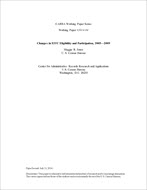
An official website of the United States government
Here’s how you know
Official websites use .gov
A .gov website belongs to an official government organization in the United States.
Secure .gov websites use HTTPS
A lock (
) or https:// means you’ve safely connected to the .gov website. Share sensitive information only on official, secure websites.
-
//
- Census.gov /
- Library /
- Census Working Papers /
- Changes in EITC Eligibility and Participation, 2005—2009
Changes in EITC Eligibility and Participation, 2005—2009
Changes in EITC Eligibility and Participation, 2005—2009
Abstract
The rate of participation in the Earned Income Tax Credit (EITC) has been widely studied, but changes over time in eligibility for the credit have received less attention. One question of importance to policy-makers is whether (or by how much) eligibility might increase during economic downturns. The EITC is fundamentally tied to work. During periods of high unemployment, eligibility may de-crease due to a lower number of workers—especially low-skilled workers—filing for a given tax year. On the other hand, family structure and underemployment may lead to increases in eligibility. For example, earners may become eligible when a two-earner family loses one job or when an earner works part of the year or fewer hours. Using IRS tax data linked with the Current Population Survey Annual Social and Economic Supplement (CPS ASEC), I examine changes in EITC eligibility and take-up between tax years 2005 and 2009, during which time the Great Recession began and ended. Employing fixed-effects models, I assess patterns of eligibility among demographic groups based on characteristics that also predict labor market outcomes. Results indicate that, in a period when overall EITC eligibility rates increased, the state unemployment rate had a significant positive effect on eligibility and a significant negative effect on take-up. Meanwhile, although joint filers, those with more children, and men experienced increasing rates of eligibility, those with less education experienced decreasing rates. Results point to the possibility that labor market groups who experienced the highest rates of unemployment in the recession may have become ineligible due to full-year job loss.
Others in Series
Working Paper
Working Paper
Working Paper
Share
Some content on this site is available in several different electronic formats. Some of the files may require a plug-in or additional software to view.
 Yes
Yes
 No
NoComments or suggestions?


Top

